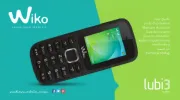Wiko Lubi3 Bruksanvisning
Wiko
Smartphone
Lubi3
Läs gratis den bruksanvisning för Wiko Lubi3 (162 sidor) i kategorin Smartphone. Guiden har ansetts hjälpsam av 33 personer och har ett genomsnittsbetyg på 4.4 stjärnor baserat på 17 recensioner. Har du en fråga om Wiko Lubi3 eller vill du ställa frågor till andra användare av produkten? Ställ en fråga
Sida 1/162

User guide
Guide d’utilisation
Manuale di utilizzo
Guía del usuario
Guia de utilização
Bedienungsanleitung
Handleiding
لﻌﺘﺳﻻا ﻞﻴﻟد
Produktspecifikationer
| Varumärke: | Wiko |
| Kategori: | Smartphone |
| Modell: | Lubi3 |
| Vikt: | 65 g |
| Bredd: | 44.5 mm |
| Djup: | 13.8 mm |
| Höjd: | 108 mm |
| Batterikapacitet: | 800 mAh |
| Skärm diagonal: | 1.77 " |
| Upplösning: | 128 x 160 pixlar |
| Pekskärm: | Nej |
| Wi-Fi: | Nej |
| Bluetooth-version: | 3.0+HS |
| Ljudformat som stöds: | AAC, AMR, MP3, WAV |
| Videoformat som stöds: | AVI, MP4 |
| GPS: | Nej |
| Videoinspelning: | Ja |
| E-post: | Nej |
| Antal färger: | 65 536 färger |
| FM-radio: | Ja |
| Videosamtal: | Nej |
| USB-version: | 1.1 |
| Inbyggd blixt: | Ja |
| Internminne: | - MB |
| Taltid (2G): | 10.67 h |
| USB-anslutning: | Micro-USB |
| Musikspelare: | Ja |
| Extern display: | Nej |
| Stöd för flashkort: | Ja |
| WAP: | Nej |
| Telefonbokskapacitet: | 200 poster |
| Batteriteknik: | Litium-Ion (Li-Ion) |
| Typ av minneskort: | MicroSD (TransFlash) |
| Produktens färg: | Blå |
| Skärmtyp: | TFT |
| Hörlursanslutning: | 3,5 mm |
| Formfaktor: | Bär |
| Paneltyp: | TFT |
| MMS (Multimedia Messaging Service): | Nej |
| Body SAR (EU): | 0.473 W/kg |
| Kabel inkluderad: | Micro-USB |
| SIM-kortskapacitet: | Dubbla SIM-kort |
| Videouppspelning: | Ja |
| Flash-typ: | LED |
| Samtal väntar: | Ja |
| Bildkomprimeringsformat: | BMP, GIF, JPG, PNG |
| Snabbuppringning: | Ja |
| USB-port: | Ja |
| Upplösning (numerisk), bakre kamera: | 0.3 MP |
| Bildupplösning vid videoinspelning (max): | 128 x 160 pixlar |
| SIM-korttyp: | Mini-SIM |
| Bluetooth: | Ja |
| Manual: | Ja |
| Bakre kamera: | Ja |
| Datanät: | GSM |
| 2G-band (primary SIM-kort): | 900,1800,1900 MHz |
| Passningstid (2G): | 190 h |
| PIM (Personal Info Management): | Alarm clock, Calculator |
| Headset medföljer: | Ja |
| Samtalstimer: | Ja |
| Prenumerationstyp: | Inget abonnemang |
| Head SAR: | 0.86 W/kg |
| Navigationstangent: | Ja |
| Högsta minneskortskapacitet: | 32 GB |
| Kamera inkluderad: | Ja |
| 2G-band (sekundärt SIM-kort): | 900,1800,1900 MHz |
Behöver du hjälp?
Om du behöver hjälp med Wiko Lubi3 ställ en fråga nedan och andra användare kommer att svara dig
Smartphone Wiko Manualer

24 Oktober 2024

9 September 2024

9 September 2024

8 September 2024

8 September 2024

8 September 2024

8 September 2024

8 September 2024

8 September 2024

7 September 2024
Smartphone Manualer
- Wolfgang
- Itel
- Intex
- Iget
- Alba
- Lumigon
- InFocus
- Zipy
- Neffos
- O2
- Doogee
- Prestigio
- Alcatel-Lucent
- Hannspree
- CAT
Nyaste Smartphone Manualer

2 April 2025

30 Mars 2025

10 Mars 2025

7 Mars 2025

6 Mars 2025

5 Mars 2025

3 Mars 2025

2 Mars 2025

26 Februari 2025

26 Februari 2025